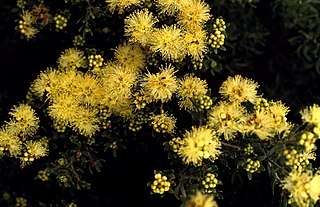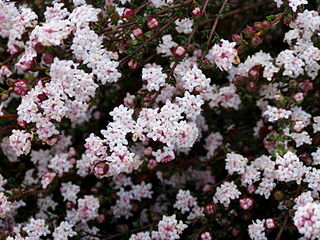
Agonis is a genus in the plant family Myrtaceae. All are endemic to Western Australia, growing near the coast in the south west.

Taxandria juniperina commonly known as wattie, native cedar, Warren River cedar or juniper myrtle is a species of tree that grows in the south west corner of Western Australia. This plant was previously classified as Agonis juniperina but is now part of the genus Taxandria. The Noongar peoples know the tree as watti.

Kunzea baxteri, commonly known as scarlet kunzea, is a flowering plant in the myrtle family Myrtaceae, and is endemic to the south-west of Western Australia where it occurs near granite outcrops and hills. It is a shrub with large, scarlet, bottlebrush-like flower clusters, making it popular as a garden feature.

Paragonis grandiflora is a plant species, endemic to the southwest of Western Australia.

Melaleuca acuminata, commonly known as mallee honeymyrtle is a plant in the myrtle family, Myrtaceae and is native to Australia and widespread in temperate areas of the continent. It is an erect shrub to about 3 m (9.8 ft) usually found in mallee woodland.

Melaleuca araucarioides is a plant in the myrtle family, Myrtaceae and is endemic to a small area of the south-west Western Australia. It is a many-branched shrub with the leaves arranged in a way that gives the plant the appearance of a conifer.

Melaleuca lecanantha is a plant in the myrtle family, Myrtaceae and is endemic to a small area of south-west Western Australia. It is a shrub with small, rather fleshy leaves and pink to lilac-coloured flowers in early spring. The plant was first described in 1867 but the name given to it was considered illegitimate and it was not until 1998 that it was first formally described.

Melaleuca leiopyxis is a shrub in the myrtle family, Myrtaceae and is endemic to an area near the west coast of Western Australia. It has bright yellow flowers and is very similar to Melaleuca depressa. The ranges of the two species overlap making it difficult to distinguish between them.

Melaleuca incana subsp. tenella is a plant in the myrtle family Myrtaceae which is endemic to the south coast of Western Australia. It was formerly known as Melaleuca tenella Benth. but was reduced to a subspecies in 1998. It is similar to M. incana subsp. incana except in the form of the plant, the size and shape of its leaves, its flowering time and distribution.

Melaleuca acutifolia is a plant in the myrtle family, Myrtaceae and is endemic to the south-west of Western Australia. It has small, pointed, oval leaves and in summer, heads of white flowers. The species was originally described as a variety of Melaleuca lateriflora but was raised to species status in 2010.

Melaleuca lateriflora, commonly known as gorada, is a plant in the myrtle family, Myrtaceae and is endemic to the south-west of Western Australia. It is usually an erect shrub with oval leaves and small clusters of white flowers mainly along the older branches.
Melaleuca oldfieldii is a plant in the myrtle family, Myrtaceae, and is native to the south-west of Western Australia. It is distinguished by its bright yellow flower heads but its distribution is restricted to one national park.

Melaleuca polycephala is a shrub in the myrtle family, Myrtaceae, and is endemic to the south-west of Western Australia. It is a sparsely foliaged, twiggy shrub with deep purple flowers in spring.
Calothamnus glaber is a plant in the myrtle family, Myrtaceae and is endemic to near-coastal areas in the south-west of Western Australia. It is a shrub, similar to Calothamnus blepharospermus but its leaves are slightly longer and narrower and the parts of its flowers are glabrous.

Beaufortia cyrtodonta, commonly known as Stirling Range bottlebrush, is a plant in the myrtle family, Myrtaceae and is endemic to the southwest of Western Australia. It is a compact shrub with crowded leaves which appear greyish due to their covering of fine, soft hairs. It has heads of red flowers in spring and occurs in the Stirling Range district.

Beaufortia empetrifolia, commonly known as south coast beaufortia, is a plant in the myrtle family, Myrtaceae and is endemic to the southwest of Western Australia. It is a highly branched shrub with small, crowded leaves and pinkish to purple flowers in small, bottlebrush-like spikes in the warmer months. It is similar to Beaufortia micrantha except that its leaves are slightly larger.

Pimelea brachyphylla is a species of flowering plant in the family Thymelaeaceae and is endemic to the south-west of Western Australia. It is an erect to spreading shrub with linear to elliptic leaves and clusters of white, tube-shaped flowers.
Beaufortia raggedensis, commonly known as Mount Ragged beaufortia, is a plant in the myrtle family, Myrtaceae and is endemic to the southwest of Western Australia. It is a compact shrub with densely clustered leaves and large heads of deep red flowers in spring and only occurs near Mount Arid in the Cape Arid National Park.
Baeckea pachyphylla is a species of flowering plant in the family Myrtaceae and is endemic to the south of Western Australia. It is a shrub with bilaterally flattened leaves and small white flowers with two to eight stamens.
Baeckea uncinella is a species of flowering plant in the family Myrtaceae and is endemic to the south coast of Western Australia. It is a shrub with narrowly egg-shaped to linear leaves and small white flowers with seven to thirteen stamens.

















